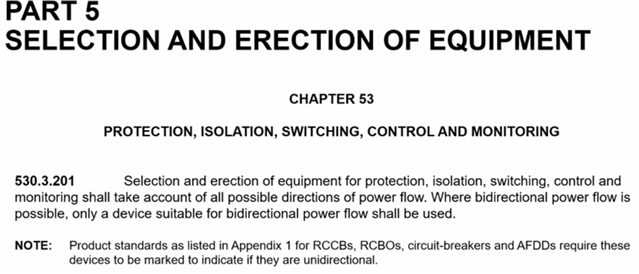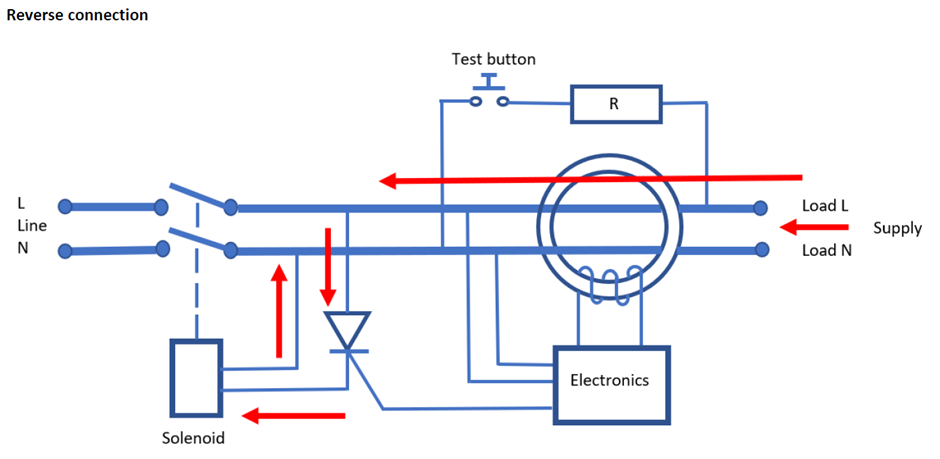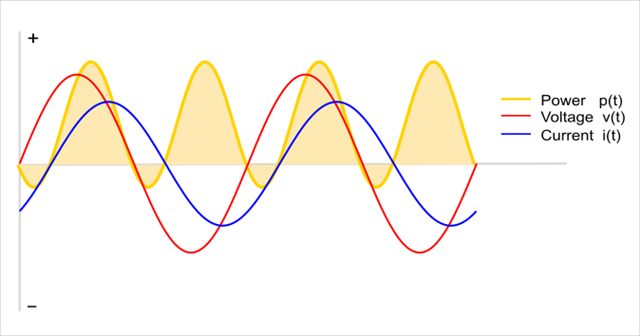I had an email this morning from the IET telling me that a Draft for Public Consultation has been published for Amendment 3 to BS 7671.
Details here electrical.theiet.org/.../
JP
I had an email this morning from the IET telling me that a Draft for Public Consultation has been published for Amendment 3 to BS 7671.
Details here electrical.theiet.org/.../
JP
Just based on Mark Cole's video....


OK, I'm confused already (I know, with me it's easily done...)
First thought - does this cover my simple PV system? In the grand scheme of things power only flows one way - backwards - from the Inverter to the CU. So not bi-directional? At a more detailed level the inverter does draw a little power overnight (just to keep the grid fail monitoring and general logging going) - would such tiny amounts (<1W from memory) count as making it bi-directional?
Second thought was for inductive (or indeed capacitive) loads - with a power factor other than unity (1.0) - if I've understood AC theory correctly, some power flows backwards during part of each cycle (hence the difference between W and VA, or the so-called "wattless current") - so is it allowable to add up instantaneous power over a period (allowing some backward power to be cancelled out) before deciding whether the overall power flow is bi-directional or not? if so, how long? A single cycle, or perhaps longer - e.g. would a machine that mostly drew power, but occasionally used say re-generative breaking to push waste power back into the grid, count?
Maybe I've missed something somewhere (or forgotten what I already knew - that seems to happen more often these days) - but what are the physical effects we're trying to avoid with all this? If it's purely down to power flow it presumably doesn't matter if voltage is left on the "load" terminals when the device is open (otherwise we'd have caveats for devices connected in parallel or back-feed situations), and normal current flows in both directions anyway (on each half cycle), so nothing can be polarity sensitive in the conventional sense (like semiconductors) or the way an arc breaks.. . or can it?
- Andy.
But whilst the fault current from the grid is typically in the kA region, the maximum short circuit that an inverter can feed is mentioned in it's datasheet and typically <=32A.
If you look in BS EN 61009-1 at the tests that are different for bi-directional devices - they are only tested differently to unidirectional devices for the detemination of Isc and Icn [9.12.11.4 b)1) & c) respectively].
It follows that if you know the maximum short circuit current that can flow upstream through a device is < 1.5kA then it makes no difference.
Interestingly bi-directional devices aren't - according to EN 61009-1 - actually functionally tested in all 4 quadrants other than for Isc and Icn.
Well, no, bi-directional. A fault in that circuit be fed from either side, and in theory, power could flow either way ... most importantly, even if only for a (potentially very short) time, power will be available on live conductors on both sides of the device even if it operates
That seems to be a different definition again - power being available (i.e. voltage present?) isn't quite the same as power flowing, especially when the device is open. That would seem to catch cases where there's individual protection to parallel conductors of the like shown in appendix 10 - with the typical arrangement of nothing but loads on the load end, I'm not sure many would have thought that it constituted bi-directional power flow - especially for the supply end devices, yet when the first device opens there'll be voltage on both sets of terminals.
- Andy.
The proposed amendment BS 7671:2018+A3:2024 follows a BEAMA technical bulletin concerning connection of unidirectional and bidirectional protective devices such as Circuit-Breakers, RCDs and AFDDs to power supplies, such as PV inverters, Electrical Energy Storage Systems (EESS) and Vehicle to Grid (V2G) electric vehicles (EV).
The issue highlighted in the BEAMA technical bulletin is regarding the ‘line’ and ‘load’ convention. The relevant product standards, such as BS EN 61009 require protective devices such as RCBOs to be marked to indicate ‘line’ and ‘load’, or ‘in’ and ‘out’. The concern is that if a power supply, such as a PV inverter is connected to the ‘load’ or ‘out’ terminals of a unidirectional RCBO, parts of the electronic circuit can be damaged.
When a residual current is detected by the current transformer, a signal is sent to the electronics from the secondary winding, which in turn opens the gate of the thyristor and allows current to flow to the solenoid. This causes the solenoid to operate resulting in the operation of the switching mechanism and opening of the contacts which interrupts the current flow.
The important thing here is that once a signal enters the thyristor gate and activates the device, it will continue to pass current until the voltage drops below a specific level. In the event of an earth fault or using the test button, the RCBO will trip but there will still be a voltage present on the load terminals from the PV inverter resulting in current flowing through the thyristor and the solenoid being activated for an extended length of time.
The thyristor and solenoid are short time rated components, any delay in interrupting the supply will result in damage to these components rendering the residual current detection inoperable. The design of RCBOs will vary between manufacturers, the thyristor and solenoid are one example of the components that can become damaged.
Where Moulded Case Circuit Breakers (MCCBs) are reverse connected, their arc extinguishing/short-circuit characteristics could be impaired.
The diagram below shows reverse connection of a unidirectional RCBO.
I hope this is helpful.

I hope this is helpful.
Michael, it is indeed. :-)
What about ordinary (domestic/commercial/light industrial) MCBs?
I ask because the most suitable piece of roof of my house is adjacent to a DB, which is supplied through an MCB - no need for an RCD and the other circuits have RCBOs. If the wiggly amps can come back down those cables and back through the MCB for onward consumption elsewhere in the house (or further away), happy days!
(My MCBs are labelled, "2" and "1" for supply and load respectively, so all seems well.)
What about ordinary (domestic/commercial/light industrial) MCBs?
Domestic MCB's typically don't have any electronic controls in them unlike some MCCB's, but always check the MI's because someone is likely to have made one.
One thing that was missed [or not deemed relevant] by BEAMA and by Michael's excellent article in Wiring Matters [https://electrical.theiet.org/wiring-matters/years/2024/99-march-2024/bidirectional-protective-devices/] is that whereas RCBO's&RCD's may use a variety of terms to indicate directionality, an MCB/MCCB must use the arrow indication as the relevant standards for those devices dictate that an arrow must be used. I think it's worth noting.
The thyristor and solenoid are short time rated components, any delay in interrupting the supply will result in damage to these components rendering the residual current detection inoperable. The design of RCBOs will vary between manufacturers, the thyristor and solenoid are one example of the components that can become damaged.
This is very interesting. Although I've noticed that almost every RCCD on the market is bi-directional whereas RCBO's typically aren't - so my understanding from 61008-1 and 61009-1 was that when interrupting a fault of >1.5kA it would cook the electronics. But this got me thinking - RCCD's usually meet short circuit current withstand by coordination with a SCPD, and 61008-1 provides for this. But that particular test is performed with the SCPD upstream of the RCCD [See figure 7 BS EN 61008-1:2012+A12:2017] - the opposite of how we normally connect them.
I wonder how they would perform if that test was turned on it's head? Maybe RCCD's aren't quite as bidirectional as their MI's suggest?
I hope this is helpful.
yes much so - thank-you!
Which then begs the question about other situations where the load side doesn't immediately become dead as soon as the device opens. E.g. feeding capacitive or inductive loads, or even decent sized motors that may gradually spin down over many seconds, acting as an impromptu generator. We've had many reports over the years of RCD testers being fooled into thinking RCDs haven't opened or opened too slowly by the effects of connected loads. If 0.5s PV disconnection times may be too long. a lot of these other sources presumably must be contenders too?
- Andy.
So in a nutshell this is really aimed at any devices using residual current monitoring circuitry to trip the device because when the load becomes the source in a bi-directional application, the supply to the tripping solenoid is on the wrong side of the tripping contacts to be disconnected from the fault current when it trips ??
As I understand it, not just RCDs - other devices (e.g. some MCCBs) can suffer similarly, and presumably some AFDDs (with or without RCD function included) might too? There might be related problems even with simple fuse carriers - e.g. older types that leave one end of the fuse connected to the load circuit as it's being changed (but as a shock hazard rather than equipment damage, but basically the same cause - having a voltage where it wasn't expected).
I think 'bi-directional power flow" isn't a particularly helpful concept here. The problem arises when the device is open, which means there's no power flow at that point and it occurs in many situations where the intended power flow isn't obviously two-way (e.g. simple PV system - power flows from from the panels to the installation - never the other way around) or with individual protection of conductors in parallel (e.g. as per appendix 10) Someone in one of the videos preferred to describe it as 'voltage on the load terminal(s) when the device is open' - which feels a lot better to me (but probably still needs some qualification/explanation).
- Andy.
So the net effect of this is if there is any ambiguity in the way a device will function, specify a bidirectional device.. Is the preference for describing current flow as power flow now suggesting that this only applies where you expect a load in both directions to exceed X VA ??.. mixed metrics, mixed messages..
I'm not sure that describing current flow is very meaningful on an AC circuit. the current reverses its direction of flow 100 times a second, whichever side of the device the generator is on.
But you can distinguish power flow between one direction and the other.
I'm not sure that describing current flow is very meaningful on an AC circuit. the current reverses its direction of flow 100 times a second, whichever side of the device the generator is on.
But you can distinguish power flow between one direction and the other.
But you can distinguish power flow between one direction and the other.
But even then it's not that clear cut. Take this example of the current/voltage and resulting instantaneous power when feeding an slightly inductive load (pinched from an excellent article on the Open Enegery Monitor site - https://docs.openenergymonitor.org/electricity-monitoring/ac-power-theory/introduction.html)
so power actually flows both ways in any non-trival situation, even if by convention we sometimes ignore it.
- Andy.
We're about to take you to the IET registration website. Don't worry though, you'll be sent straight back to the community after completing the registration.
Continue to the IET registration site